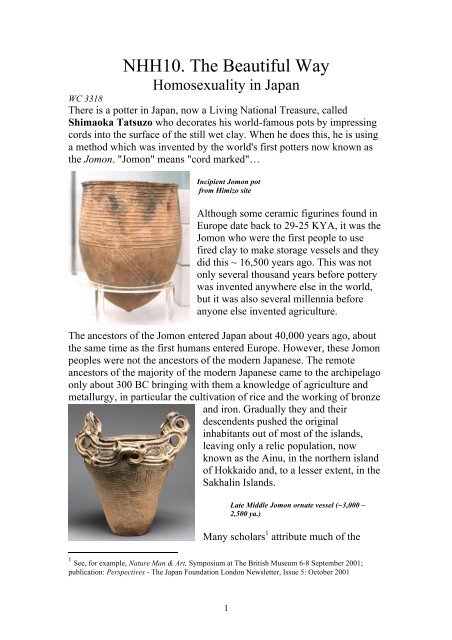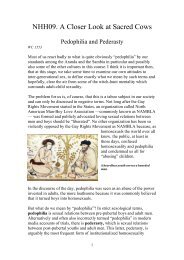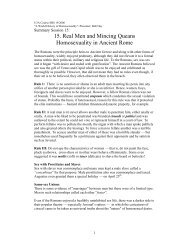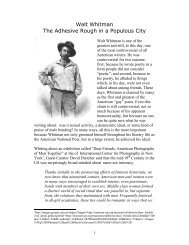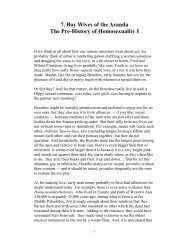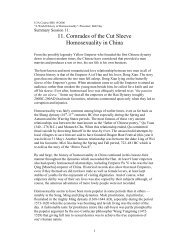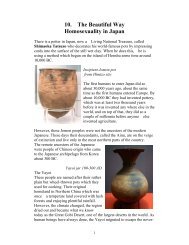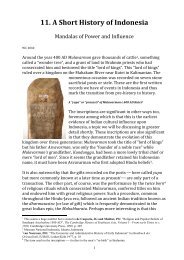NHH 10 The Beautiful Way - Homosexuality in Japan
NHH 10 The Beautiful Way - Homosexuality in Japan
NHH 10 The Beautiful Way - Homosexuality in Japan
Create successful ePaper yourself
Turn your PDF publications into a flip-book with our unique Google optimized e-Paper software.
<strong>NHH</strong><strong>10</strong>. <strong>The</strong> <strong>Beautiful</strong> <strong>Way</strong><br />
<strong>Homosexuality</strong> <strong>in</strong> <strong>Japan</strong><br />
WC 3318<br />
<strong>The</strong>re is a potter <strong>in</strong> <strong>Japan</strong>, now a Liv<strong>in</strong>g National Treasure, called<br />
Shimaoka Tatsuzo who decorates his world-famous pots by impress<strong>in</strong>g<br />
cords <strong>in</strong>to the surface of the still wet clay. When he does this, he is us<strong>in</strong>g<br />
a method which was <strong>in</strong>vented by the world's first potters now known as<br />
the Jomon. "Jomon" means "cord marked"…<br />
Incipient Jomon pot<br />
from Himizo site<br />
Although some ceramic figur<strong>in</strong>es found <strong>in</strong><br />
Europe date back to 29-25 KYA, it was the<br />
Jomon who were the first people to use<br />
fired clay to make storage vessels and they<br />
did this ~ 16,500 years ago. This was not<br />
only several thousand years before pottery<br />
was <strong>in</strong>vented anywhere else <strong>in</strong> the world,<br />
but it was also several millennia before<br />
anyone else <strong>in</strong>vented agriculture.<br />
<strong>The</strong> ancestors of the Jomon entered <strong>Japan</strong> about 40,000 years ago, about<br />
the same time as the first humans entered Europe. However, these Jomon<br />
peoples were not the ancestors of the modern <strong>Japan</strong>ese. <strong>The</strong> remote<br />
ancestors of the majority of the modern <strong>Japan</strong>ese came to the archipelago<br />
only about 300 BC br<strong>in</strong>g<strong>in</strong>g with them a knowledge of agriculture and<br />
metallurgy, <strong>in</strong> particular the cultivation of rice and the work<strong>in</strong>g of bronze<br />
and iron. Gradually they and their<br />
descendents pushed the orig<strong>in</strong>al<br />
<strong>in</strong>habitants out of most of the islands,<br />
leav<strong>in</strong>g only a relic population, now<br />
known as the A<strong>in</strong>u, <strong>in</strong> the northern island<br />
of Hokkaido and, to a lesser extent, <strong>in</strong> the<br />
Sakhal<strong>in</strong> Islands.<br />
1<br />
Late Middle Jomon ornate vessel (~3,000 –<br />
2,500 ya.)<br />
Many scholars 1 attribute much of the<br />
1 See, for example, Nature Man & Art, Symposium at <strong>The</strong> British Museum 6-8 September 2001;<br />
publication: Perspectives - <strong>The</strong> <strong>Japan</strong> Foundation London Newsletter, Issue 5: October 2001
emphasis upon craftsmanship, design and beauty <strong>in</strong> <strong>Japan</strong>ese culture to<br />
the Jomon people who, unlike most cultures <strong>in</strong> the world, experienced<br />
many thousands of years of un<strong>in</strong>terrupted and peaceful existence dur<strong>in</strong>g<br />
which they developed a remarkable partnership with Nature. Much of this<br />
sense of aff<strong>in</strong>ity with Nature lives on <strong>in</strong> "Sh<strong>in</strong>to", one of the three official<br />
religions of contemporary <strong>Japan</strong>. In this religion, almost everyth<strong>in</strong>g that is<br />
wondrous has a spirit, a “kami” ⎯⎯ people, natural events and places, even<br />
domestic utensils and packag<strong>in</strong>g, can have one of these “kami” liv<strong>in</strong>g<br />
temporarily <strong>in</strong> it and is therefore worthy of respect and appreciation 2 .<br />
Confucian and Buddhist teachers first arrived <strong>in</strong> <strong>Japan</strong> (<strong>in</strong> 513 and 522<br />
AD respectively), mostly aga<strong>in</strong> from Korea, and with them, the art of<br />
writ<strong>in</strong>g. However, written records don’t exist until the 7 th century.<br />
Significantly, although the Yamato court of those times adopted Ch<strong>in</strong>ese<br />
writ<strong>in</strong>g, the Ch<strong>in</strong>ese calendar and a Ch<strong>in</strong>ese form of government, a<br />
Constitution imposed by Pr<strong>in</strong>ce Shotoku <strong>in</strong> 604 AD effectively made<br />
Buddhism the state religion. <strong>Japan</strong> thus became a nation with three<br />
religions, Confucian, Buddhism and their ancestral Sh<strong>in</strong>to.<br />
It was <strong>in</strong> the Buddhist monasteries dur<strong>in</strong>g the latter part of the Classical<br />
age, the Heian period, 794-1192 AD that a form of <strong>in</strong>stitutionalised<br />
homosexuality emerged. This was known as nanshoku 3 .<br />
Nanshoku and the Buddhist monks:<br />
<strong>The</strong> moral position of homosexuality <strong>in</strong> old <strong>Japan</strong> was well summed up <strong>in</strong><br />
what appears to be a term paper for an English class written by an<br />
anonymous <strong>Japan</strong>ese student: 4<br />
Sh<strong>in</strong>to and Buddhism……… do not regard homosexuality as a s<strong>in</strong>.<br />
Sh<strong>in</strong>to is a creed that teaches harmony, sanctity of human life and<br />
nature and respect for people and their <strong>in</strong>dividuality. It has no<br />
developed theology or sacred scriptures, and thus there are no<br />
clear-cut tenets on sexuality………… <strong>The</strong>y do not consider<br />
wrongdo<strong>in</strong>gs as “s<strong>in</strong>”, but as actions which dirty one’s purity, to<br />
be cleansed to preserve one’s <strong>in</strong>ner peace. As far as Sh<strong>in</strong>to was<br />
2 <strong>The</strong>se beliefs are what anthropologists call “animism”, a term taken from the Lat<strong>in</strong> “anima” mean<strong>in</strong>g<br />
the breath or soul. <strong>The</strong> concept was first <strong>in</strong>troduced by British anthropologist Sir Edward Burnett Tylor<br />
<strong>in</strong> his book "Primitive Culture" (published <strong>in</strong> 1871). the term was widely criticized <strong>in</strong> the N<strong>in</strong>eteenth<br />
Century but has s<strong>in</strong>ce ga<strong>in</strong>ed general acceptance. Animism is believed to be the oldest form of religion,<br />
com<strong>in</strong>g to us from at least the Paleolithic and possibly well beyond.<br />
3 From the Ch<strong>in</strong>ese “nanse”, written with the same characters and which has the same mean<strong>in</strong>g<br />
although the Ch<strong>in</strong>ese did not have the same altruistic overtones as the <strong>Japan</strong>ese.<br />
4 http://www.tabulas.com/~syzygy/content/18124.html<br />
2
concerned, homosexual activity was acceptable as long as it did<br />
not disrupt the community, an aspect of human liv<strong>in</strong>g which the<br />
religion also places <strong>in</strong> high regard.<br />
Mahayana Buddhism <strong>in</strong> the <strong>Japan</strong>ese context also does not classify<br />
deeds as “good” or “evil” by themselves, but by their <strong>in</strong>tention<br />
and outcome. This <strong>Japan</strong>ese understand<strong>in</strong>g of Buddhism<br />
considered an <strong>in</strong>tention as either “skillful” or “unskillful” <strong>in</strong><br />
lessen<strong>in</strong>g attachment to our world of suffer<strong>in</strong>g, which we are born<br />
<strong>in</strong>to…… Buddhism did not concern itself with procreation, as it<br />
re<strong>in</strong>forced the cycle of rebirths; however, <strong>in</strong> Mahayana Buddhism,<br />
sex was used as a religious symbol and <strong>Japan</strong>ese Buddhism<br />
separated sex from procreation, see<strong>in</strong>g sex as a good <strong>in</strong> itself.<br />
One of the most important figures to emerge <strong>in</strong> <strong>Japan</strong>ese history — at<br />
least from our po<strong>in</strong>t of view — was a Buddhist monk called Kukai (774-<br />
835) who studied for a long time at monstries <strong>in</strong> T’ang Dynasty Ch<strong>in</strong>a<br />
and from there, brought back to <strong>Japan</strong> a form of Buddhism called “True<br />
Words” or, <strong>in</strong> <strong>Japan</strong>ese, Sh<strong>in</strong>gon. This became the most <strong>in</strong>fluential form<br />
of Buddhism <strong>in</strong> <strong>Japan</strong>ese culture. In expla<strong>in</strong><strong>in</strong>g this, Richard Hooker 5<br />
wrote:<br />
3<br />
Statue of Kukai<br />
Kukai believed<br />
that the True<br />
Words<br />
transcended<br />
speech, so he<br />
encouraged the<br />
cultivation of<br />
artistic skills:<br />
pa<strong>in</strong>t<strong>in</strong>g, music,<br />
and gesture. Anyth<strong>in</strong>g that had beauty revealed the truth of the<br />
Buddha; as a result, the art of the Hiei monks made the religion<br />
profoundly popular at the Heian court and deeply <strong>in</strong>fluenced the<br />
development of <strong>Japan</strong>ese culture that was be<strong>in</strong>g forged at that<br />
court. It is not unfair to say that <strong>Japan</strong>ese poetic and visual art<br />
beg<strong>in</strong> with the Buddhist monks of Mount Hiei and Mount Koya.<br />
5 Richard Hooker: on “World Civilisations – an Internet Classroom and Anthology”, Wash<strong>in</strong>gton State<br />
University at http://www.wsu.edu:8080/~dee/ANCJAPAN/YAYOI.HTM
It is commonly believed that it was Kukai himself who <strong>in</strong>troduced a form<br />
of homosexual activity which became <strong>in</strong>stitutionalised with<strong>in</strong> the Mt<br />
Koya monastery he founded on his return from Ch<strong>in</strong>a. This was called<br />
nanshoku which literally means “male colours” but is generally used to<br />
mean male-male love and specifically refers to the practice of monks<br />
form<strong>in</strong>g sexual alliances with their younger acolytes or chigo. 6 Whether<br />
it was true or not that Kukai himself was responsible is open to question,<br />
but the monastery at Mt Koya became a by-word for same-sex love, the<br />
monks rationalis<strong>in</strong>g their affairs with younger chigo on the grounds that<br />
the vow of chastity applied only to sex with women and not to sex with<br />
males because it was not procreative. A whole literature evolved of<br />
stories about love relations among monks and their young acolytes known<br />
as Chigo Monogatari. 7 Although these began <strong>in</strong> the N<strong>in</strong>th century, the<br />
practice of nanshoku persisted, becom<strong>in</strong>g more idealised as time went by.<br />
So, for example, when the first Portuguese traders made contact with<br />
<strong>Japan</strong> <strong>in</strong> the 15 th Century, the Jesuit priests who accompanied them<br />
reported home <strong>in</strong> horror that sodomy was plentiful <strong>in</strong> the Buddhist<br />
monasteries.<br />
<strong>The</strong> Love of Warriors — <strong>The</strong> <strong>Beautiful</strong> <strong>Way</strong><br />
In the early days of battles between uji or clans, the war chiefs led the<br />
men of the clan <strong>in</strong>to war, much as we might understand battles between<br />
the Scots clans. In the early “Classical” era, dur<strong>in</strong>g the Nara period (7<strong>10</strong>-<br />
794 AD), a system of local militias of mounted horsemen was<br />
established. Although orig<strong>in</strong>ally these men were the servants or samurai<br />
of the Emperor, gradually the militias evolved <strong>in</strong>to private armies ow<strong>in</strong>g<br />
loyalty to the great aristocratic families.<br />
<strong>The</strong>se early samurai were not the noble and cultured professional soldiers<br />
who followed the code later called bushido or “the way of the warrior”<br />
but men drawn from the lower classes who spent most of their time<br />
earn<strong>in</strong>g a liv<strong>in</strong>g as farmers and became soldiers only when their lords<br />
called upon them to fight oppos<strong>in</strong>g armies. <strong>The</strong> samuari who lived<br />
accord<strong>in</strong>g to the bushido did not emerge until the Tokugawa shogunate<br />
which began <strong>in</strong> the 17 th Century. By then the Samurai had become a class<br />
of highly tra<strong>in</strong>ed, discipl<strong>in</strong>ed professional soldiers who hired themselves<br />
out to clan chiefs and great houses dur<strong>in</strong>g the middle ages <strong>in</strong> <strong>Japan</strong>.<br />
6<br />
Gary Leupp: Male Colors: <strong>The</strong> Construction of <strong>Homosexuality</strong> <strong>in</strong> Tokugawa <strong>Japan</strong>, Berkeley:<br />
University of California Press, 1995.<br />
7 th<br />
<strong>The</strong>re were other references to homosexuality <strong>in</strong> other literature of the times: see, for example the 11<br />
century Genji Monogatari or <strong>The</strong> Tale of Genji.<br />
4
It was among these later, far more sophisticated and socially elevated<br />
samurai that the most famous <strong>Japan</strong>ese homosexual <strong>in</strong>stitution was to<br />
emerge.<br />
If, like me, you are a fan of the movies made by the <strong>Japan</strong>ese director,<br />
Akira Kurosawa, you will be familiar with the ways of the Samurai but<br />
<strong>in</strong> none of Kurosawa’s movies will you see even a h<strong>in</strong>t of one of their<br />
great driv<strong>in</strong>g <strong>in</strong>stitutions, the wakashudo (the way of youth) or bi-do (the<br />
beautiful way).<br />
Writ<strong>in</strong>g <strong>in</strong> the 2004 Androphile Project 8 , an unsigned author commented:<br />
….one of the fundamental aspects of samurai life was the<br />
emotional and sexual bond cultivated between an older warrior<br />
and a younger apprentice, a love for which the <strong>Japan</strong>ese have<br />
many names, as many perhaps as the Eskimo have for snow.<br />
With the advantage of be<strong>in</strong>g <strong>in</strong> the right place at the right time, another<br />
writer, Ijiri Chusuke 9 , argued <strong>in</strong> 1482 that:<br />
“In our empire of <strong>Japan</strong> this way flourished from the time of the<br />
great master Kobo. In the abbeys of Kyoto and Kamakura, and <strong>in</strong><br />
the world of the nobles and the warriors, lovers would swear<br />
perfect and eternal love rely<strong>in</strong>g on no more than their mutual good<br />
will. Whether their partners were noble or common, rich or poor,<br />
was absolutely of no importance…”<br />
Fortunately, we can get a glimpse of the “beautiful way” at the movies<br />
with the 1999 film, released <strong>in</strong> Australia under the title of “Taboo” but<br />
orig<strong>in</strong>ally called “Gohatto”, directed by Nagisa Oshima (Merry<br />
Christmas Mr Lawrence, In the Realm of the Senses, etc). In this sensual<br />
and dream-like movie set <strong>in</strong> 1865, three years before the fall of the<br />
Tokugawa shogunate, we see the havoc a very beautiful if flirtatious<br />
youth creates when he jo<strong>in</strong>s a group of samurai, several of whom then<br />
compete with each other for his favours.<br />
<strong>The</strong> same anonymous Androphile author also writes:<br />
8 Androphile Project 2004, http://www.androphile.org/preview/Culture/<strong>Japan</strong>/japan.htm<br />
9 Ijiri Chusuke, 1482 "<strong>The</strong> Essence of Jakudo" <strong>in</strong> <strong>The</strong> Love of the Samurai, A Thousand Years of<br />
<strong>Japan</strong>ese <strong>Homosexuality</strong> by Tsuneo Watanabe and Jun’ichi Iwata, 1989, London, <strong>The</strong> Gay Men’s<br />
Press, p. <strong>10</strong>9.<br />
5
Known also as wakashudo, “the way of the youth”, it was a<br />
practice engaged <strong>in</strong> by all members of the samurai class, from<br />
lowliest warrior to highest lord. Indeed it has been said that it<br />
would never have been asked of a daimyo, (or lord), why he took<br />
boys as lovers, but why he didn’t. <strong>10</strong><br />
Although <strong>in</strong> many ways like pederasty <strong>in</strong> Ancient Greece, wakashudo —<br />
usually abbreviated to shudo —differed <strong>in</strong> one major respect <strong>in</strong> that <strong>in</strong><br />
<strong>Japan</strong> it was the adolescent youth who sought out and wooed the older<br />
man, and not the other way around as <strong>in</strong> Greece. However, as <strong>in</strong> Greece,<br />
the sexual part of the relationship customarily ended when the youth<br />
reached manhood, usually around age 19 or so. Of course that did not<br />
mean the men ceased to know each other: most commonly a close<br />
friendship lasted for the rest of their lives and, <strong>in</strong> some cases, the men<br />
cont<strong>in</strong>ued the erotic relationship long past the conventional time. As <strong>in</strong><br />
Greece, this shudo relationship did not rule out marriage because most<br />
Samurai married but generally, later <strong>in</strong> life than was common among<br />
other classes.<br />
As <strong>in</strong> Greece and as we have seen <strong>in</strong> other parts of the world also, it was<br />
firmly believed that the relationship between man and youth was<br />
essentially a way of transmitt<strong>in</strong>g the manly virtues from one generation to<br />
the other and that this was done, not only by the older man serv<strong>in</strong>g as a<br />
good role model, but also through sexual <strong>in</strong>tercourse of one form or<br />
another. Just as the monks on Mount Koya argued that sex<br />
was itself a means of explor<strong>in</strong>g the spiritual world, so too the physical<br />
relationship between man and youth took on a spiritual mean<strong>in</strong>g <strong>in</strong> the<br />
shudo. In 1653, <strong>in</strong> a book called , “A Dog’s Idle Hours” (Inu Tsurezure)<br />
an anonymous author wrote:<br />
“It is natural for a samurai to make every effort to excel with pen<br />
and sword. Beyond that, what is important to us is not ever to<br />
forget, even to our last moment, the spirit of shudo. If we should<br />
forget it, it will not be possible for us to ma<strong>in</strong>ta<strong>in</strong> the decencies,<br />
nor gentleness of speech, nor the ref<strong>in</strong>ements of polite behavior.” 11<br />
<strong>10</strong><br />
Gary P. Leupp, 1995, Male Colors, the Construction of <strong>Homosexuality</strong> <strong>in</strong> Tokugawa <strong>Japan</strong>, Berkely,<br />
<strong>The</strong> University of California Press, p. 53.<br />
11<br />
William Scott Wilson, trans. 1979. Yamamoto Tsunetomo, Hagakure, <strong>The</strong> Book of the Samurai New<br />
York and Tokyo, Kodansha International, p. 58.<br />
6
Honoured and <strong>in</strong>deed, revered as it was, shudo was not to be entered <strong>in</strong>to<br />
lightly. A boy was admonished to seek out and observe a man for at least<br />
five years before he approached him and requested the apprentice-like<br />
7<br />
Male couple on a<br />
futon: Early<br />
1680's; One of the<br />
very first<br />
examples of handcolored<br />
ukiyo-e<br />
pr<strong>in</strong>ts <strong>in</strong> the<br />
shunga (erotic)<br />
style. Moronobu<br />
Hishikawa (1618-<br />
1694); Ôban<br />
format, <strong>10</strong>.25" x<br />
15"; Sumi <strong>in</strong>k and<br />
color on paper;<br />
Private collection.<br />
relationship. This meant that boys, some time before they were of an age<br />
to enter shudo, would have had to be consider<strong>in</strong>g the available adult men<br />
because they generally underwent the com<strong>in</strong>g-of-age ceremony when<br />
they were about 18-19 years old. It was at this time that the youth<br />
received the tonsure <strong>in</strong> which his hair was shaved back from his forehead<br />
to emulate a reced<strong>in</strong>g hairl<strong>in</strong>e and thus appear older (<strong>in</strong> <strong>Japan</strong>, age<br />
matters – people compare birthdays <strong>in</strong> order to know who should bow a<br />
little lower to the other).<br />
Although shudo among the Samurai owed much to the nanshoku of the<br />
Buddhist monks of the Heian era, it reached its peak dur<strong>in</strong>g the<br />
Tokugawa shogunate which began <strong>in</strong> 1603 12 but from that time on, the<br />
practice gradually decl<strong>in</strong>ed as the country became <strong>in</strong>creas<strong>in</strong>gly unified<br />
and the need for a warrior class dim<strong>in</strong>ished.<br />
<strong>Homosexuality</strong> among the Middle-Classes<br />
<strong>The</strong> long period of peace dur<strong>in</strong>g the Tokugawa shogunate saw the rise of<br />
a middle class along with the growth of trade. For a time, they even<br />
traded with Europe, the <strong>Japan</strong>ese want<strong>in</strong>g firearms and shipbuild<strong>in</strong>g<br />
skills, the Europeans after silks and ceramics. 13 <strong>Japan</strong> orig<strong>in</strong>ally opened<br />
its doors, first to the Portuguese <strong>in</strong> 1542 and later, to the Dutch, but it<br />
12 which <strong>in</strong>cidentally, was the year Elizabeth I died and James VI of Scotland succeeded her as James I.<br />
13 A good read on the subject is Giles Milton: “Samurai William, <strong>The</strong> Adventurer Who Unlocked<br />
<strong>Japan</strong>”, Hodder & Stoughton, London 2002.
slammed them shut aga<strong>in</strong> and conf<strong>in</strong>ed the Dutch to the one small trad<strong>in</strong>g<br />
entrepot at Nagasaki, pr<strong>in</strong>cipally because they disliked the activities of<br />
Jesuit and Franciscan missionaries and their <strong>in</strong>tolerant attitudes to Sh<strong>in</strong>to<br />
and Buddhism.<br />
Dur<strong>in</strong>g this period, the traditions of both shudo and nanshoku <strong>in</strong>filtrated<br />
the high society which became known as the “Float<strong>in</strong>g World”, the life <strong>in</strong><br />
the pleasure quarters of the cities, but especially Edo from about the 17 th<br />
until the end of the 19 th centuries. This was the world depicted <strong>in</strong> many of<br />
the famous <strong>Japan</strong>ese wood-block pr<strong>in</strong>ts, the ukiyo-e. While we th<strong>in</strong>k of<br />
this as the time of geisha and the tea-ceremony, it is also the time when<br />
the kobuki and no theatres were at their peak of popularity. In these<br />
theatres, as <strong>in</strong> Shakespeare's time, young male actors played female roles,<br />
their made-up faces com<strong>in</strong>g to considered the ideal of female beauty!<br />
Kabuki actors known as kagema, became the media stars of their day,<br />
able to charge fortunes for their sexual favours from the wealthy patrons<br />
who pursued them.<br />
This form of male prostitution gave rise to countless literary and artistic<br />
works with many of the greatest artists of the time document<strong>in</strong>g both the<br />
kagema and their activities. Although some of the better-known artists<br />
used false names to protect their reputation, few could avoid produc<strong>in</strong>g<br />
ukiyo-e (“pictures of the float<strong>in</strong>g world”) or, where their pictures were<br />
more erotic, what were known as shunga (“pictures of spr<strong>in</strong>g”). Great<br />
artists whose names are household words among Western collectors, such<br />
as Hokusai and Hiroshige, produced works of this k<strong>in</strong>d.<br />
Spr<strong>in</strong>g Pastimes — A tryst between an older man and a youth — by Miyagawa Isshô, ca.<br />
1750. This is a Shunga hand-scroll (sumi, color and gofun on silk) a dalliance between an<br />
older man and a young kabuki actor (known as onnagata or kagema) who often doubled as<br />
rent-boys and were much sought after by the “stage door johnnies” of their day.<br />
8
<strong>The</strong> Tokugawa shogunate also saw the emergence of a male cult known<br />
as onnagirai. <strong>The</strong>se were the “women haters”, men who were exclusively<br />
homosexual <strong>in</strong> their behaviour. This stands out aga<strong>in</strong>st the bisexuality<br />
which had always been traditional <strong>in</strong> <strong>Japan</strong>ese culture. Of course there<br />
had long been an attitude that women were “unclean” and that sex with<br />
women “polluted” a man’s spirit, the pollution hav<strong>in</strong>g to be lifted by<br />
appropriate religious rituals. To some degree, this was the basis for both<br />
nanshoku among the monks and shudo among the samurai, but it had not<br />
before become an <strong>in</strong>stitutionalized form of exclusive homosexuality.<br />
<strong>The</strong> end of shudo and the float<strong>in</strong>g world<br />
In 1868 the decrepit Tokugawa shogunate was ended by the Meiji<br />
Restoration and <strong>Japan</strong> was prised open for bus<strong>in</strong>ess with the West by<br />
American gun-ships. This of course is the time of Madama Butterfly!<br />
Increas<strong>in</strong>gly conscious of the outside world’s view of them, the <strong>Japan</strong>ese<br />
began to hide and eventually abolish the old sexual traditions which had<br />
become embarrass<strong>in</strong>g <strong>in</strong> the world of <strong>in</strong>ternational relations. In<br />
comparison, the Meiji period was rather wowserish and “Victorian” <strong>in</strong><br />
our terms, so much so that WS Gilbert <strong>in</strong> “<strong>The</strong> Mikado” sent it up by<br />
mak<strong>in</strong>g behead<strong>in</strong>g the punishment for flirt<strong>in</strong>g!<br />
<strong>Homosexuality</strong> <strong>in</strong> modern <strong>Japan</strong><br />
<strong>The</strong>re are no laws aga<strong>in</strong>st homosexual behaviour <strong>in</strong> modern <strong>Japan</strong> but the<br />
old open acceptance has gone, banished from public gaze especially by<br />
the American occupation follow<strong>in</strong>g the Second World War. However, of<br />
course homosexual behaviour still goes on even if it is now someth<strong>in</strong>g to<br />
be kept private and considered by the society at large to be rather<br />
shameful. But, as Mark McLelland 14 from Murdoch University reports:<br />
…… representations of (primarily male) homosexual love and even<br />
sex permeate <strong>Japan</strong>ese popular culture to an extent that would be<br />
unimag<strong>in</strong>able <strong>in</strong> the US or Europe and that 'homosexuality' <strong>in</strong><br />
<strong>Japan</strong> is therefore very differently conceptualised.<br />
However, I must po<strong>in</strong>t out that the visibility of 'homosexuality' <strong>in</strong><br />
<strong>Japan</strong>ese media such as comic books, women's magaz<strong>in</strong>es, TV<br />
dramas and talk-shows, movies and popular fiction has not created<br />
the space for <strong>in</strong>dividuals express<strong>in</strong>g lesbian or gay 'identities' to<br />
14 Mark McLelland: <strong>Homosexuality</strong> and Popular Culture <strong>in</strong> Modern <strong>Japan</strong>,<br />
http://wwwsshe.murdoch.edu.au/<strong>in</strong>tersections/issue3/mclelland2.html<br />
9
come out <strong>in</strong> actual life. Yet, as recent research has shown 15 , the<br />
notion of 'com<strong>in</strong>g out' is seen as undesirable by many <strong>Japan</strong>ese gay<br />
men and lesbians as it necessarily <strong>in</strong>volves adopt<strong>in</strong>g a<br />
confrontational stance aga<strong>in</strong>st ma<strong>in</strong>stream lifestyles and values,<br />
which many still wish to endorse.<br />
It is difficult to assess exactly what is meant by “homosexuality” <strong>in</strong> <strong>Japan</strong><br />
because the media seem to conflate same-sex desire with cross-dress<strong>in</strong>g<br />
and trans-genderism and at times to portray it as a k<strong>in</strong>d of “hobby” or a<br />
form of “play”. This rather confused and trivializ<strong>in</strong>g attitude can be best<br />
seen <strong>in</strong> two major <strong>in</strong>stitutions of <strong>Japan</strong>ese contemporary life: <strong>in</strong> the comic<br />
books called manga and their animated form, called anime.<br />
Anime and Manga<br />
Many manga and anime conta<strong>in</strong> male homosexual stories and bedroom<br />
scenes. S<strong>in</strong>ce the 1970s, a genre of manga and anime has developed<br />
especially for women fasc<strong>in</strong>ated by the “boy-love” theme, a genre<br />
<strong>in</strong>creas<strong>in</strong>gly written and drawn by women themselves. <strong>The</strong>se feature very<br />
stylized, fem<strong>in</strong>ised youths, known as bishoonen which many<br />
commentators argue are not really men but:<br />
…fantastic, androgynous creatures created by <strong>Japan</strong>ese women as<br />
an expression of dissatisfaction with current gender stereotypes<br />
and the 'narrow life paths' which restrict women <strong>in</strong> the real<br />
world. 16<br />
However, there is evidence that these notions are more than just daydreams<br />
for many women who, s<strong>in</strong>ce the early '90s, have come to believe<br />
it is better to live with and even to marry a gay man. As McLelland<br />
reports, these women believe gay men have qualities straight men lack,<br />
<strong>in</strong>clud<strong>in</strong>g a will<strong>in</strong>gness to negotiate roles with<strong>in</strong> the marriage and to help<br />
with housework.<br />
Relationships between straight women and gay men are also the focus of<br />
what are called "gay boom" movies <strong>in</strong> which a common theme is<br />
'camouflage marriage'. <strong>The</strong>se marriages are undertaken to avoid the<br />
<strong>in</strong>tense social pressures on both partners to marry and are welcomed by<br />
women because they believe gay men offer them ……the k<strong>in</strong>d of love,<br />
appreciation and respect denied to them by straight men.<br />
15 McLelland refers to his own Male <strong>Homosexuality</strong> <strong>in</strong> Modern <strong>Japan</strong>: Cultural Myths and Social<br />
Realities, Richmond: Curzon Press – then <strong>in</strong> press; and to Wim Luns<strong>in</strong>g, Beyond Common Sense,<br />
1999a.<br />
16 McLelland, ibid.<br />
<strong>10</strong>
“Boy-love” yaoi (Manga for women)<br />
<strong>Japan</strong>ese fem<strong>in</strong>ist writer, Ueno<br />
Chizuko 17 states that<br />
11<br />
'neither men nor women are<br />
sleep<strong>in</strong>g with the opposite sex,<br />
they are sleep<strong>in</strong>g with a system'<br />
which always works to the<br />
disadvantage of women. So<br />
women turn to images of sex<br />
between men which are, as one<br />
woman [said] 18 , ……….. the<br />
only picture we have of men<br />
lov<strong>in</strong>g someone else as an<br />
equal. It is the k<strong>in</strong>d of love we<br />
want to have.'<br />
__________________________________________<br />
17<br />
Ueno Chizuko, Sukaato no shita no gekiba [<strong>The</strong> theater under the skirt), Tokyo: Kawade Bunko,<br />
1992, p. 140., quoted <strong>in</strong> McLelland, ibid.<br />
18<br />
Sarah Schulman, My American History: Lesbian and Gay Life Dur<strong>in</strong>g the Reagan and Bush Years,<br />
London: Cassell, 1994, p. 245.


